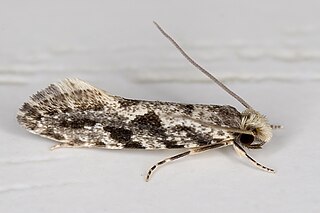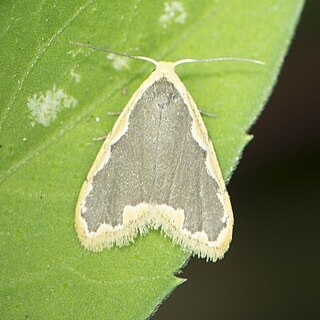Related Research Articles

Synanthedon tipuliformis, known as the currant clearwing, is a moth of the family Sesiidae. It is endemic to the Palearctic realm, but is an invasive species in the Nearctic realm and the Australasian realm.

Nemapogon granella is a species of tineoid moth. It belongs to the fungus moth family (Tineidae), and therein to the subfamily Nemapogoninae. It is the type species of its genus Nemapogon, and via that also of the subfamily Nemapogoninae. It is also the type species of the proposed genera Brosis and Diaphthirusa, which are consequently junior objective synonyms of Nemapogon.

Papilio ambrax, the Ambrax butterfly, is a butterfly of the family Papilionidae. It is found in Queensland, Australia, as well as the Aru Islands, Papua (Indonesia), and Papua New Guinea.

Sphenarches zanclistes is a moth of the family Pterophoridae that is found in Australia.
Pollanisus nielseni is a moth of the family Zygaenidae. It inhabits the Australian state of Western Australia, mostly coastal areas, and has brilliantly shiny forewings. The diurnal adults are most active on sunny days. Eggs are laid on the plant Hibbertia spicata, and females touch each egg after oviposition with a tuft of hair on their abdomen, which attaches protective spines. The larvae are brightly coloured and feed on H. spicata before pupation.
Ectopatria virginea is a moth of the family Noctuidae. It is found in South Australia.
Batrachedra helarcha is a species of moth of the family Batrachedridae. It is found in Australia.
Batrachedra holochlora is a species of moth of the family Batrachedridae. It is found in Australia.
Batrachedra leucophyta is a species of moth of the family Batrachedridae. It was described by Edward Meyrick in 1897 and is found in Australia.
Batrachedra phorcydia is a species of moth of the family Batrachedridae. It is found in Australia.
Batrachedra sterilis is a species of moth of the family Batrachedridae. It is found in Australia.
Batrachedra volucris is a species of moth of the family Batrachedridae. It is found in Australia.
Agamopsyche is a genus of moths in the family Epipyropidae. It consists of only one species Agamopsyche threnodes, which is found in Queensland.
Palaeopsyche is a genus of moths in the family Epipyropidae. It consists of only one species Palaeopsyche melanias, which is found in the wet tropics of Queensland.
Heteropsyche is a genus of moths in the Epipyropidae family.
Heteropsyche micromorpha is a moth in the family Epipyropidae. It is found in Australia.
Heteropsyche poecilochroma is a moth in the family Epipyropidae. It is found in Australia.

Diduga flavicostata is a species of moth in the family Erebidae first described by Snellen in 1879. It is found on Java, as well as in Australia, India, Sri Lanka, Myanmar, Malaysia, China and Japan.
References
- ↑ Perkins, R. C. L. (1905). "Leaf-Hoppers and their Natural Enemies (Pt. II. Epipyropidæ) Lepidoptera". Report of the Work of the Experiment Station of the Hawaiian Sugar Planters' Association . 1 (2): 83.
- 1 2 "Species Heteropsyche stenomorpha Perkins, 1905". Australian Faunal Directory. Australian Biological Resources Study. Retrieved 29 September 2017.
- ↑ Australian Faunal Directory
- ↑
 One or more of the preceding sentences incorporates text from this source, which is in the public domain : Perkins (1905) .
One or more of the preceding sentences incorporates text from this source, which is in the public domain : Perkins (1905) .